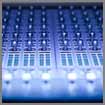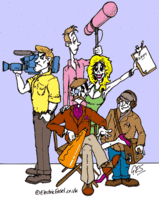 Production Sound Mixing is the complex craft of recording live dialogue and sound effects on the set during principal photography of a motion picture or video. It differs greatly from post-production Re-recording and most other audio recording arts in that the Mixer is no longer the key figure in the operation.
Production Sound Mixing is the complex craft of recording live dialogue and sound effects on the set during principal photography of a motion picture or video. It differs greatly from post-production Re-recording and most other audio recording arts in that the Mixer is no longer the key figure in the operation.
 On the set, the Production Mixer is only one of many important craftspeople involved in the making of a film or video. The production company is not out there to shoot an "audio!" Sound must do their thing in harmony with the priorities of camera, lighting, and dramatic direction; and must often take a back seat to these other aspects.
On the set, the Production Mixer is only one of many important craftspeople involved in the making of a film or video. The production company is not out there to shoot an "audio!" Sound must do their thing in harmony with the priorities of camera, lighting, and dramatic direction; and must often take a back seat to these other aspects.
A large percentage of Production Sound Mixers are not bona fide Engineers from an electronics standpoint. Very few Production Mixers possess more than the most rudimentary knowledge of audio circuitry. They know how to operate their equipment, but it is not professionally necessary to be able to perform any sort of extensive repairs. (Technicians back at the sound shop do that.)
What Sound Mixers do have to master, in addition to their own craft, is an understanding of the crafts and techniques adjacent to theirs. One cannot choreograph booms and fishpoles without understanding lighting, lenses, and camera moves.
Creative decisions regarding the soundtrack itself cannot be made without an innate familiarity of the entire editing and re-recording process. For example, knowing when the (bad) sound on a wide master shot can be replaced with the good (though not lipsync) track borrowed from a crisp, close-up.
Set etiquette is very important. Shot numbers must be gotten from the scriptperson (and confirmed with the camera assistant) for keeping accurate logs. Communication chains between talent, director, and camera must be assertive yet not overbearing. And rigging microphones under a shy actress's costume requires the utmost tact.
Filmmaking is a collaborate art! Production Sound Mixing is a part of that.
Staffing
The typical Production Sound Crew consists of two to five persons, two or three being the norm. The Mixer is the key figure and assumes responsibility for the soundtrack and the politics of the department. Side by side with the sound mixer is the Boom Operator. The Mixer and Boom man will often collaborate on determining mic placement. Features and television will have a third person, known as the Utility Sound Tech. Duties of the third person include rigging plant mics and radio mics, wrangling cable on complex moves, or working as second Boom. Scenes being shot to sync playback may require the addition of a skilled Playback Operator, as well.
Why this mention about Crewing? Because the number one cause for good studio engineers falling flat on their faces when asked to go out on a shoot is that they think (or the producer thinks) that one body can do it all. Low budget video shoots are notorious for expecting one-person crews to bring back "Hollywood" finished soundtracks.
The typical duties of a one-person crew include operating the recorder, mixing the incoming mic levels, and holding the boom -- ALL AT ONCE. Sorry folks, it just doesn't work if you're aiming for anything better than an ENG soundtrack.
There are two types of sound that a one-person crew can be expected to successfully achieve: 1) ambience; and 2) talking head.
Imagine the soundperson stuggling to hold a boompole with two hands, while controlling the mic gain (volume) with one hand, and controlling the gain of maybe one or two lavs or radio mics with another hand… Don't know about you, but my count came up short in the niumber of hands needed versus hands available.
If we remove the boom option and just try to use the audio from a camera mounted microphone, even the best condenser shotguns won't discern most dialogue from those (camera) distances. The best that a camera mic can be expected to deliver is general background ambience.
If we keep the boom option, then our sound mixer has to learn to balance the pole in one hand, while trying to control audio levels with the other. Or, ignore all of the levels, and just concentrate on the boom. Either way, it may be good enough for a reality show, but feature quality it is not!
As an alternative, lavalieres can be deployed to capture specific dialogue. However, hardwired lavs are rarely suitable for more than interviews, spokesman standups, or limited drama. Radio mics can provide greater talent mobility, but have the drawbacks of RF interference and dropout. Lavalieres in general may create a problem with audio perspective (the intimate, close-up sound does not match the camera angle) and phasing. There are also the inherent problems of clothing noise and body movement. Wrangling multiple lavaliers is never as easy as Producers imagine. Just ask the editor who has to sort out the mess.
A two-person sound crew would be able, on the other hand, to record all but the most complex dramatic scenes. Because the Boom man is a separate entity, he or she is free to move in close to the sound source and to follow talent, enabling better dialogue recording. The Mixer is now able to divert full attention to mixing the incoming signals. Even when talent is placed on a lav or radio mic, the boom man can round out the track by miking the subtle detail, such as footsteps, hand props, and other natural effects.
